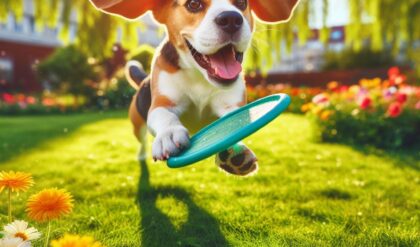Beagles are fun-loving and intelligent dogs, but their strong scent-driven nature can make them a bit challenging to train. Training a beagle requires patience, consistency, and the right techniques to help them listen and behave effectively. In this comprehensive guide, we will explore key tips and strategies on how to train a beagle successfully.

Starting Early: Establishing a Foundation for Training
1.1 Understanding Your Beagle’s Characteristics
Beagles have a keen sense of smell and a high energy level, which can make training a bit more demanding compared to other breeds. They are also known for their stubbornness at times, so it’s essential to approach training with a positive and patient mindset.
When starting training with your beagle puppy, it’s crucial to establish yourself as the pack leader early on. Be firm, consistent, and use positive reinforcement techniques to encourage good behavior.
1.2 Setting Up a Training Routine
Consistency is key when training a beagle, so setting up a regular training routine is essential. Designate specific times during the day for training sessions, keeping them short and engaging to maintain your beagle’s focus.
Training sessions should be positive and rewarding for your beagle, so incorporate treats, toys, and plenty of praise to reinforce good behavior. Beagles respond well to positive reinforcement, so remember to reward them immediately after they demonstrate the desired behavior.
1.3 Socialization and Exposure
Socialization is critical for beagles to develop good behavior and become well-rounded companions. Introduce your beagle to various environments, people, and animals from a young age to help them feel comfortable and confident in different situations.
Regular exposure to new experiences will help prevent fear and aggression in your beagle, promoting good manners and sociable behavior. Create positive interactions with other dogs and people to reinforce positive social skills in your beagle.
Leash Training: Teaching Your Beagle to Stay Close
2.1 Importance of Leash Training
Beagles have a strong hunting instinct due to their history as scent hounds, making them prone to chasing scents and wandering off. Leash training is crucial to teach your beagle to stay close to you and follow commands while out on walks or in public spaces.
Start leash training your beagle from a young age to instill good walking habits and prevent pulling or excessive sniffing. Choose a sturdy and comfortable leash for your beagle, ensuring a secure connection that allows you to maintain control during walks.
2.2 Techniques for Leash Training
Begin leash training in a quiet and familiar environment, gradually introducing distractions as your beagle becomes more comfortable and responsive. Use positive reinforcement techniques such as treats and praise to encourage your beagle to walk nicely on the leash without pulling or lunging.
Practice loose leash walking regularly with your beagle, rewarding them for staying by your side and following your lead. Be patient and consistent with leash training, addressing any unwanted behaviors promptly and redirecting your beagle’s attention back to you.
2.3 Tips for Successful Leash Training
- Use a Harness: Consider using a harness instead of a collar for leash training, as it distributes pressure more evenly and reduces strain on your beagle’s neck.
- Stay Calm and Positive: Maintain a calm and positive attitude during leash training sessions, as your beagle will pick up on your emotions and respond accordingly.
- Practice Patience: Remember that leash training takes time and commitment, so be patient with your beagle and celebrate small victories along the way.
Table 1: Leash Training Schedule
| Week | Training Activity |
|---|---|
| 1 | Introduction to leash and collar |
| 2 | Leash walking in a quiet environment |
| 3 | Leash walking with mild distractions |
| 4 | Advanced leash training techniques |
| 5 | Outdoor walks in different settings |
Key Commands: Building Obedience in Your Beagle
3.1 Importance of Basic Obedience
Basic obedience training is essential for teaching your beagle fundamental commands that promote good behavior and responsiveness. Commands such as sit, stay, come, and heel can help you establish control and communication with your beagle in various situations.
Focus on one command at a time during training sessions, keeping them short and engaging to maintain your beagle’s interest. Practice consistently and gradually increase the difficulty level as your beagle becomes more proficient in following commands.
3.2 Training Techniques for Key Commands
Use positive reinforcement techniques such as treats, toys, and praise to motivate your beagle to learn and obey basic commands. Break down each command into simple steps, rewarding your beagle for small achievements and progress towards the desired behavior.
Practice key commands in different environments and situations to generalize your beagle’s learning and ensure reliability. Incorporate training into daily routines and activities to reinforce obedience and establish a strong bond with your beagle.
3.3 Troubleshooting Common Issues
- Lack of Focus: If your beagle seems distracted during training, try using high-value treats or toys to regain their attention and motivation.
- Inconsistency: Be consistent with your commands, rewards, and expectations to avoid confusion and maintain clarity during training sessions.
- Patience and Persistence: Remember that learning takes time, so stay patient and persistent with your beagle until they master the key commands successfully.
List 1: Essential Key Commands for Beagle Training
- Sit
- Stay
- Come
- Heel
- Leave It
- Down
Behavioral Challenges: Addressing Common Training Issues
4.1 Dealing with Separation Anxiety
Beagles are social dogs that thrive on human interaction, making them prone to separation anxiety when left alone for extended periods. To prevent and address separation anxiety, gradually desensitize your beagle to being alone and create a safe and comfortable space for them when you’re away.
Provide interactive toys, puzzle feeders, and comforting items such as blankets or clothing with your scent to keep your beagle occupied and reassured in your absence. Establish a routine for departures and arrivals to create predictability and reduce anxiety in your beagle.
4.2 Managing Excessive Barking
Beagles are known for their vocal nature and tendency to bark, especially when bored, lonely, or seeking attention. To manage excessive barking, identify the triggers that cause your beagle to bark and address them proactively through training, exercise, and mental stimulation.
Engage your beagle in regular physical exercise and mental challenges to keep them physically and mentally stimulated, reducing the likelihood of excessive barking. Teach your beagle alternative behaviors such as quiet commands and focus exercises to redirect their attention and discourage barking.
4.3 Curbing Destructive Behavior
Beagles are energetic dogs that require adequate physical and mental stimulation to prevent boredom and destructive behavior. Provide interactive toys, puzzles, and chew bones to keep your beagle engaged and entertained, reducing the risk of destructive chewing or digging.
Create a designated space or area for your beagle to play and relax, ensuring they have outlets for their natural behaviors and instincts. Supervise your beagle during playtime and training to correct undesirable behaviors promptly and redirect their focus onto acceptable activities.
Table 2: Behavioral Challenges and Solutions
| Behavioral Issue | Training Solution |
|---|---|
| Separation Anxiety | Gradual Desensitization, Interactive Toys, Comfort Items |
| Excessive Barking | Identify Triggers, Exercise, Mental Stimulation, Quiet Commands |
| Destructive Behavior | Interactive Toys, Designated Play Area, Supervision, Redirecting |
Advanced Training Techniques: Taking Your Beagle’s Skills to the Next Level
5.1 Agility Training for Beagles
Agility training is an excellent way to challenge your beagle both physically and mentally, promoting fitness, coordination, and focus. Set up agility courses with tunnels, jumps, weave poles, and ramps to engage your beagle in exciting and stimulating challenges.
Introduce agility training gradually, starting with basic obstacles and increasing the difficulty level as your beagle gains confidence and proficiency. Use positive reinforcement and rewards to motivate your beagle during agility training, making it a fun and rewarding experience for both of you.
5.2 Scent Work and Tracking
Given their exceptional sense of smell, beagles excel in scent work and tracking activities that stimulate their natural abilities. Engage your beagle in scent detection games, hide-and-seek activities, and tracking exercises to channel their scent-driven instincts in a positive and enriching way.
Provide opportunities for your beagle to use their nose and problem-solving skills through scent work, encouraging mental stimulation and engagement. Incorporate scent work into your training routine to keep your beagle challenged and fulfilled, tapping into their innate hunting abilities.
5.3 Advanced Obedience Commands
Once your beagle has mastered basic obedience commands, you can introduce more advanced commands to further enhance their training and communication skills. Commands such as “fetch,” “roll over,” and “back up” can provide mental stimulation and strengthen the bond between you and your beagle.
Practice advanced obedience commands in a controlled environment, breaking them down into manageable steps and rewarding your beagle for successful execution. Keep training sessions engaging and challenging to keep your beagle motivated and eager to learn new skills.
List 2: Benefits of Advanced Training Techniques
- Mental Stimulation
- Physical Fitness
- Bond Strengthening
- Skill Development
Conclusion
Training a beagle requires patience, consistency, and understanding of their unique characteristics and needs. By starting early, focusing on key commands, addressing behavioral challenges, and incorporating advanced training techniques, you can help your beagle become a well-behaved and enjoyable companion. Remember to tailor your training approach to your beagle’s personality and preferences, and always prioritize positive reinforcement and rewards to encourage good behavior. With dedication and commitment, you can train your beagle to be a happy, obedient, and well-adjusted member of your family.






